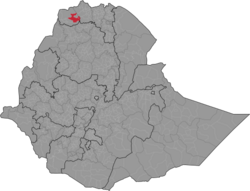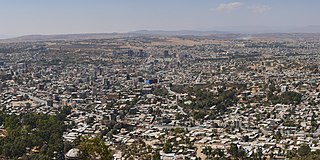
Mekelle, or Mekele, is a special zone and capital of the Tigray Region of Ethiopia. Mekelle was formerly the capital of Enderta awraja in Tigray. It is located around 780 kilometres (480 mi) north of the Ethiopian capital Addis Ababa, with an elevation of 2,254 metres (7,395 ft) above sea level. Administratively, Mekelle is considered a Special Zone, which is divided into seven sub-cities. It is the economic, cultural, and political hub of northern Ethiopia.
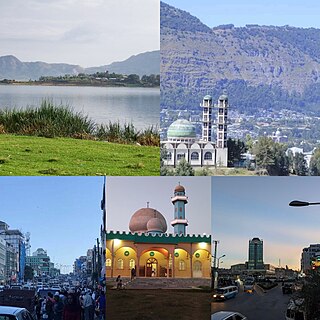
Dessie is a town in north-central Ethiopia. Located in the South Wollo Zone of the Amhara Region, it sits at a latitude and longitude of 11°8′N39°38′E, with an elevation between 2,470 and 2,550 metres above sea level. Dessie is 400 km to the north of the capital Addis Ababa. It has a population of more than 200,000 people in over 30 wards.

Debre Tabor is a town and woreda in northern Ethiopia. Located in the Debub Gondar Zone of the Amhara Region, about 100 kilometers southeast of Gondar and 50 kilometers east of Lake Tana, this historic town has a latitude and longitude of 11°51′N38°1′E with an elevation of 2,706 metres (8,878 ft) above sea level. The presence of at least 48 springs in the area contributed to the development of Debre Tabor.
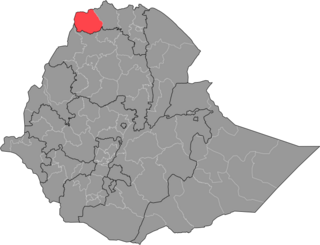
The Western Zone is a zone in the Tigray Region of Ethiopia. It is subdivided into three woredas (districts); from north to south they are Kafta Humera, Welkait and Tsegede. The largest town is Humera. The Western Zone is bordered on the east by the North Western Zone, the south by the Amhara Region, the west by Sudan and on the north by Eritrea. Starting from the late 17th C., internal boundaries are clearly shown, with 37 maps displaying a boundary that is located well south of the Tekeze River, or even south of the Simien mountains. Welkait is explicitly included within a larger Tigray confederation ; it is briefly mapped as part of Amhara in 1891-1894 and part of Gondar from 1944-1990. At other periods it appears independent or part of a larger Mezaga lowland region.

Humera is a town in the Kafta Humera woreda in the Tigray Region of Ethiopia. Located in the Western Zone the town has an elevation of 585 metres (1,919 ft) above sea level. The Tekezé river borders the town to the north. Humera is a very important regional agricultural center based on intensive agriculture. It is the last Ethiopian town south of the border with Eritrea and Sudan, and is considered to be a strategically important gateway to Sudan.

La'ilay Adiyabo is a woreda in the Tigray Region of Ethiopia. Part of the North Western Zone, La'ilay Adiyabo is bordered on the south by Tahtay Koraro, on the southwest by Asigede Tsimbela, on the northwest by Tahtay Adiyabo, on the northeast by the Mareb River which separates it from Eritrea, on the east by the Central Zone, and on the southeast by Medebay Zana. The administrative center of this woreda is Addi Daero; other towns in La'ilay Adiyabo include Addi Nebreid.

Medebay Zana is an Ethiopian District or woreda in the Tigray Region of Ethiopia. Part of the Semien Mi'irabawi Zone, Medebay Zana is bordered on the south by the Tekeze River which separates Tahtai Adyabo from Tselemti, on the southwest by Asgede Tsimbla, on the northwest by Tahtay Koraro, on the north by La'ilay Adyabo, and on the east by the Mehakelegnaw (Central) Zone. The administrative center of this woreda is Selekhlekha; other towns in Medebay Zana include Debre Kerbe.

Tsimbla is a woreda in Tigray Region, Ethiopia. Part of the Semien Mi'irabawi Zone, Tsimbla is bordered along the south by the Tekeze River which separates the woreda on the south from Tselemti and to the west by the Asgede, then on the northwest by Tahtay Adyabo, on the north by La'ilay Adiyabo, on the northeast by Tahtay Koraro, and on the east by Medebay Zana. The administrative center of this woreda is in Inda Aba Guna, a separate town; other towns in Tsimbla include Adi Gebru and Debre Abai.

Tselemti is an Ethiopian District, or woreda, in the Tigray Region of Ethiopia. Part of the Semien Mi'irabawi Zone, Tselemti is bordered on the south by the Amhara Region, on the west by the Mi'irabawi Zone, on the north by Asigede Tsimbela, on the northeast by Medebay Zana, and on the east by the Maekelay Zone. The Tekezé defines the boundary between Tselemti and both the last two woredas and the Zone; other rivers in this woreda include the Abata, a tributary of the Tekezé. The administrative center of this woreda is Mai Tsebri; other towns in Tselemti include Dima.

Tanqua Abergele is one of the Districts of Ethiopia, or woredas, in the Tigray Region of Ethiopia. Part of the Mehakelegnaw Zone, Abergele is bordered on the south by the Wag Hemra Zone of Amhara Region, then by the Tekezé River on the west which separates it from North Gondar Zone of Amhara Region, on the north by Kola Tembien, on the east by Degua Tembien and on the southeast by the Debub Misraqawi Zone. The administrative center of this woreda is Yechila; other towns in Abergele include Sele and Jijike. Abergele is one of the low lying districts of central Tigray and the Tanqua River, which originates near Hagere Selam, flows through this woreda and joins the Geba just north of Jijike. It further feeds the Tekezé River. The Tekezé Dam is also located in this woreda.
Kobo or Raya Kobo is a woreda in the Amhara Region of Ethiopia. Located in the northeast corner of the North Wollo Zone, Kobo is bordered on the south by the Logiya River which separates it from Habru and Guba Lafto, on the west by Gidan, on the north by Tigray Region, and on the east by the Afar Region. Towns in Kobo include Gobiye, Kobo and Robit.
Berehet is one of the woredas in the Amhara Region of Ethiopia. Part of the Semien Shewa Zone, Berehet is bordered on the south by the Germama River which separates it from Menjarna Shenkora, on the west by Hagere Mariamna Kesem, on the north by Asagirt, and on the east by the Afar Region. The major town in Berehet is Metiteh Bila.
Dembecha Zuria is one of the woredas in the Amhara Region of Ethiopia. Part of the Mirab Gojjam Zone, Dembecha is bordered on the west by Bure, on the northwest by Jabi Tehnan, on the north by Dega Damot, and on the east and south by the Misraq Gojjam Zone. Towns in Dembecha include Addis Alem, Dembecha and Yechereka.

The North Western Zone is a zone in Tigray Region of Ethiopia. It is bordered on the east by the Central Zone, the south by the Amhara Region, the west by the Western Zone and on the north by Eritrea. The Zone is subdivided into the six woredas (districts), which are Asgede, Tsimbla, La'ilay Adiyabo, Medebay Zana, Tahtay Adiyabo, Tahtay Koraro and Tselemti. Major towns and cities in the zone include Shire, Sheraro, Inda Aba Guna, Selekleka, Adi Daero, May Tsebri. The North Western Zone was split off from Western Zone in 2005.

Fano is an ethno-nationalist Amhara militia and former protest movement. It has engaged in violent clashes throughout Ethiopia in the name of neutralizing perceived threats to the Amhara people. Fano has absorbed many units and personnel of the Amhara Regional Special Forces that did not integrate into the Ethiopian National Defense Force (ENDF). Fano militias are have been involved in armed conflicts with the Tigray People's Liberation Front (TPLF), the Oromo Liberation Army (OLA), and the ENDF. They have also clashed with the Sudanese Armed Forces (SAF) on the border of Ethiopia and Sudan.

Ethnic discrimination in Ethiopia during and since the Haile Selassie epoch has been described using terms including "racism", "ethnification", "ethnic identification, ethnic hatred, ethnicization", and "ethnic profiling". During the Haile Selassie period, Amhara elites perceived the southern minority languages as an obstacle to the development of an Ethiopian national identity. Ethnic discrimination occurred during the Haile Selassie and Mengistu Haile Mariam epochs against Hararis, Afars, Tigrayans, Eritreans, Somalis and Oromos. Ethnic federalism was implemented by Tigray People's Liberation Front (TPLF) leader Meles Zenawi and discrimination against Amharas, Ogaden, Oromos and other ethnic groups continued during TPLF rule. Liberalisation of the media after Abiy Ahmed became prime minister in 2018 led to strengthening of media diversity and strengthening of ethnically focussed hate speech. Ethnic profiling targeting Tigrayans occurred during the Tigray War that started in November 2020.
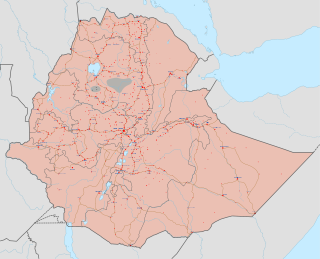
Following the 2018 dissolution of the ethnic federalist, dominant party political coalition, the Ethiopian People's Revolutionary Democratic Front, there was an increase in tensions within the country, with newly resurgent regional and ethnically based factions carrying out armed attacks on military and civilians in multiple conflicts throughout Ethiopia.

Tigrayan nationalism is an ethnic nationalism that advocates the interests of Tigrayan people in Ethiopia. Inspired predominantly by the Tigray People's Liberation Front (TPLF) with its predecessor Tigray Liberation Front (TLF), this type of nationalism holds that Tigrayans are an independent group with unique ancestry, heritage, history and culture outside Ethiopia. As such, they claim Tigray is the source of Ethiopian civilization and utterly a benefactor of state-building without other local ethnic groups. Tigrayan nationalists accuse Amharas of imposing their cultural, economic and political hegemony over Tigrayans.

Asgede is a woreda in Tigray Region, Ethiopia. Part of the Semien Mi'irabawi Zone, Asgede is bordered along the south by the Tekeze River which separates the woreda on the south from Tselemti and to the west and northwest by Tahtay Adyabo, on the north by La'ilay Adiyabo, on the northeast by Tahtay Koraro, and on the east by Tsimbla. Although Mayhansse town is the largest town and center of the woreda, corrupt cadres have deflected the administrative center to Kisad Gaba town so that they can easily work while living in Shire. Other towns include Dedebit, Adi Mehameday, Hibret and Hitsats.

The Welkait question involves a controversial territorial dispute surrounding the Ethiopian area Welkait, which is situated in the present-day Tigray Region. Welkait had been an independent area but was incorporated within Begmeder province, but after the fall of the Derg in 1991, the area was given by the TPLF government to Tigray's Western Zone. During Abiy Ahmed administration, the Tigray and Welkait Committee counterparts held peaceful talks in Gondar on 19 April 2018. Abiy pleaded the Welkait question should be addressed in peaceful resolution.
